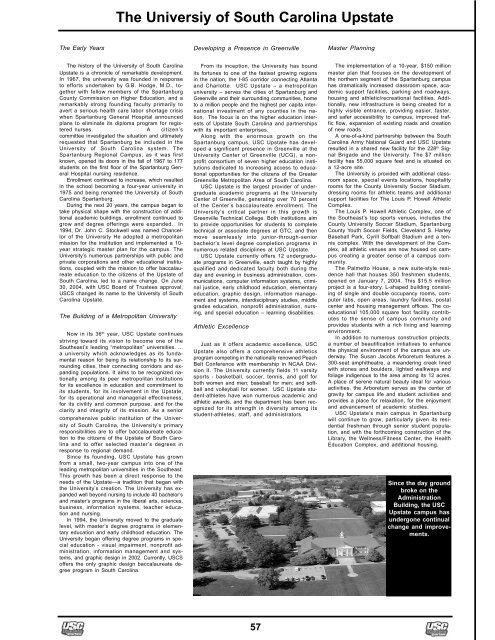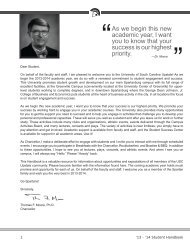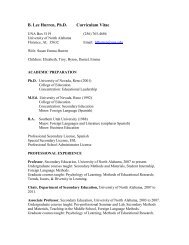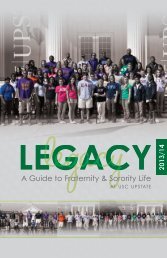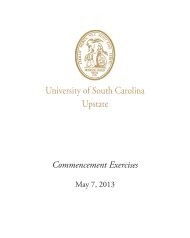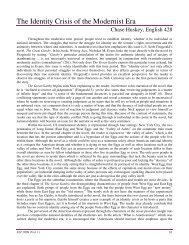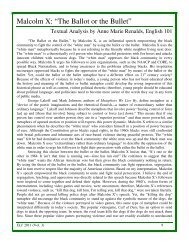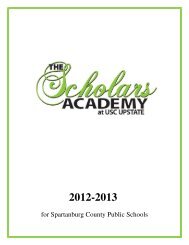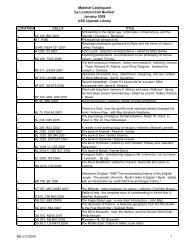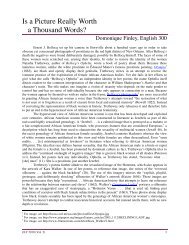Baseball • 2006 Universit University of South Carolina Upstate y of ...
Baseball • 2006 Universit University of South Carolina Upstate y of ...
Baseball • 2006 Universit University of South Carolina Upstate y of ...
- No tags were found...
You also want an ePaper? Increase the reach of your titles
YUMPU automatically turns print PDFs into web optimized ePapers that Google loves.
The Universiy <strong>of</strong> <strong>South</strong> <strong>Carolina</strong> <strong>Upstate</strong>The Early YearsDeveloping a Presence in GreenvilleMaster PlanningThe history <strong>of</strong> the <strong>Universit</strong>y <strong>of</strong> <strong>South</strong> <strong>Carolina</strong><strong>Upstate</strong> is a chronicle <strong>of</strong> remarkable development.In 1967, the university was founded in responseto efforts undertaken by G.B. Hodge, M.D., togetherwith fellow members <strong>of</strong> the SpartanburgCounty Commission on Higher Education, and aremarkably strong founding faculty primarily toavert a serious health care labor shortage crisiswhen Spartanburg General Hospital announcedplans to eliminate its diploma program for registerednurses. A citizen’scommittee investigated the situation and ultimatelyrequested that Spartanburg be included in the<strong>Universit</strong>y <strong>of</strong> <strong>South</strong> <strong>Carolina</strong> system. TheSpartanburg Regional Campus, as it was firstknown, opened its doors in the fall <strong>of</strong> 1967 to 177students on the first floor <strong>of</strong> the Spartanburg GeneralHospital nursing residence.Enrollment continued to increase, which resultedin the school becoming a four-year university in1975 and being renamed the <strong>Universit</strong>y <strong>of</strong> <strong>South</strong><strong>Carolina</strong> Spartanburg.During the next 20 years, the campus began totake physical shape with the construction <strong>of</strong> additionalacademic buildings, enrollment continued togrow and degree <strong>of</strong>ferings were expanded. In1994, Dr. John C. Stockwell was named Chancellor<strong>of</strong> the <strong>Universit</strong>y He adopted a metropolitanmission for the institution and implemented a 10-year strategic master plan for the campus. The<strong>Universit</strong>y’s numerous partnerships with public andprivate corporations and other educational institutions,coupled with the mission to <strong>of</strong>fer baccalaureateeducation to the citizens <strong>of</strong> the <strong>Upstate</strong> <strong>of</strong><strong>South</strong> <strong>Carolina</strong>, led to a name change. On June30, 2004, with USC Board <strong>of</strong> Trustees approval,USCS changed its name to the <strong>Universit</strong>y <strong>of</strong> <strong>South</strong><strong>Carolina</strong> <strong>Upstate</strong>.The Building <strong>of</strong> a Metropolitan <strong>Universit</strong>yNow in its 36 th year, USC <strong>Upstate</strong> continuesstriving toward its vision to become one <strong>of</strong> the<strong>South</strong>east’s leading “metropolitan” universities. ...a university which acknowledges as its fundamentalreason for being its relationship to its surroundingcities, their connecting corridors and expandingpopulations. It aims to be recognized nationallyamong its peer metropolitan institutionsfor its excellence in education and commitment toits students, for its involvement in the <strong>Upstate</strong>,for its operational and managerial effectiveness,for its civility and common purpose, and for theclarity and integrity <strong>of</strong> its mission. As a seniorcomprehensive public institution <strong>of</strong> the <strong>Universit</strong>y<strong>of</strong> <strong>South</strong> <strong>Carolina</strong>, the <strong>Universit</strong>y’s primaryresponsibilities are to <strong>of</strong>fer baccalaureate educationto the citizens <strong>of</strong> the <strong>Upstate</strong> <strong>of</strong> <strong>South</strong> <strong>Carolina</strong>and to <strong>of</strong>fer selected master’s degrees inresponse to regional demand.Since its founding, USC <strong>Upstate</strong> has grownfrom a small, two-year campus into one <strong>of</strong> theleading metropolitan universities in the <strong>South</strong>east.This growth has been a direct response to theneeds <strong>of</strong> the <strong>Upstate</strong>—a tradition that began withthe <strong>Universit</strong>y’s creation. The <strong>Universit</strong>y has expandedwell beyond nursing to include 40 bachelor’sand master’s programs in the liberal arts, sciences,business, information systems, teacher educationand nursing.In 1994, the <strong>Universit</strong>y moved to the graduatelevel, with master’s degree programs in elementaryeducation and early childhood education. The<strong>Universit</strong>y began <strong>of</strong>fering degree programs in specialeducation - visual impairment, nonpr<strong>of</strong>it administration,information management and systems,and graphic design in 2002. Currently, USCS<strong>of</strong>fers the only graphic design baccalaureate degreeprogram in <strong>South</strong> <strong>Carolina</strong>.From its inception, the <strong>Universit</strong>y has boundits fortunes to one <strong>of</strong> the fastest growing regionsin the nation, the I-85 corridor connecting Atlantaand Charlotte. USC <strong>Upstate</strong> – a metropolitanuniversity – serves the cities <strong>of</strong> Spartanburg andGreenville and their surrounding communities, hometo a million people and the highest per capita internationalinvestment <strong>of</strong> any counties in the nation.The focus is on the higher education interests<strong>of</strong> <strong>Upstate</strong> <strong>South</strong> <strong>Carolina</strong> and partnershipswith its important enterprises.Along with the enormous growth on theSpartanburg campus, USC <strong>Upstate</strong> has developeda significant presence in Greenville at the<strong>Universit</strong>y Center <strong>of</strong> Greenville (UCG), a nonpr<strong>of</strong>itconsortium <strong>of</strong> seven higher education institutionsdedicated to increasing access to educationalopportunities for the citizens <strong>of</strong> the GreaterGreenville Metropolitan Area <strong>of</strong> <strong>South</strong> <strong>Carolina</strong>.USC <strong>Upstate</strong> is the largest provider <strong>of</strong> undergraduateacademic programs at the <strong>Universit</strong>yCenter <strong>of</strong> Greenville, generating over 70 percent<strong>of</strong> the Center’s baccalaureate enrollment. The<strong>Universit</strong>y’s critical partner in this growth isGreenville Technical College. Both institutions aimto provide opportunities for students to completetechnical or associate degrees at GTC, and thenmove seamlessly into junior-through-seniorbachelor’s level degree completion programs innumerous related disciplines at USC <strong>Upstate</strong>.USC <strong>Upstate</strong> currently <strong>of</strong>fers 12 undergraduateprograms in Greenville, each taught by highlyqualified and dedicated faculty both during theday and evening in business administration, communications,computer information systems, criminaljustice, early childhood education, elementaryeducation, graphic design, information managementand systems, interdisciplinary studies, middlegrades education, nonpr<strong>of</strong>it administration, nursing,and special education – learning disabilities.Athletic ExcellenceJust as it <strong>of</strong>fers academic excellence, USC<strong>Upstate</strong> also <strong>of</strong>fers a comprehensive athleticsprogram competing in the nationally renowned PeachBelt Conference with membership in NCAA DivisionII. The <strong>Universit</strong>y currently fields 11 varsitysports - basketball, soccer, tennis, and golf forboth women and men; baseball for men; and s<strong>of</strong>tballand volleyball for women. USC <strong>Upstate</strong> student-athleteshave won numerous academic andathletic awards, and the department has been recognizedfor its strength in diversity among itsstudent-athletes, staff, and administrators.The implementation <strong>of</strong> a 10-year, $150 millionmaster plan that focuses on the development <strong>of</strong>the northern segment <strong>of</strong> the Spartanburg campushas dramatically increased classroom space, academicsupport facilities, parking and roadways,housing and athletic/recreational facilities. Additionally,new infrastructure is being created for ahighly visible entrance, providing easier, faster,and safer accessibility to campus, improved trafficflow, expansion <strong>of</strong> existing roads and creation<strong>of</strong> new roads.A one-<strong>of</strong>-a-kind partnership between the <strong>South</strong><strong>Carolina</strong> Army National Guard and USC <strong>Upstate</strong>resulted in a shared new facility for the 228 th SignalBrigade and the <strong>Universit</strong>y. The $7 millionfacility has 55,000 square feet and is situated ona 12-acre site.The <strong>Universit</strong>y is provided with additional classroomspace, special events locations, hospitalityrooms for the County <strong>Universit</strong>y Soccer Stadium,dressing rooms for athletic teams and additionalsupport facilities for The Louis P. Howell AthleticComplex.The Louis P. Howell Athletic Complex, one <strong>of</strong>the <strong>South</strong>east’s top sports venues, includes theCounty <strong>Universit</strong>y Soccer Stadium, SpartanburgCounty Youth Soccer Fields, Cleveland S. Harley<strong>Baseball</strong> Park, Cyrill S<strong>of</strong>tball Stadium and a tenniscomplex. With the development <strong>of</strong> the Complex,all athletic venues are now housed on campuscreating a greater sense <strong>of</strong> a campus community.The Palmetto House, a new suite-style residencehall that houses 350 freshmen students,opened on January 7, 2004. This $15.5 millionproject is a four-story, L-shaped building consisting<strong>of</strong> single and double occupancy rooms, computerlabs, open areas, laundry facilities, postalcenter and housing management <strong>of</strong>fices. The coeducational105,000 square foot facility contributesto the sense <strong>of</strong> campus community andprovides students with a rich living and learningenvironment.In addition to numerous construction projects,a number <strong>of</strong> beautification initiatives to enhancethe physical environment <strong>of</strong> the campus are underway.The Susan Jacobs Arboretum features a300-seat amphitheatre, a meandering creek linedwith stones and boulders, lighted walkways andfoliage indigenous to the area among its 12 acres.A place <strong>of</strong> serene natural beauty ideal for variousactivities, the Arboretum serves as the center <strong>of</strong>gravity for campus life and student activities andprovides a place for relaxation, for the enjoymentand advancement <strong>of</strong> academic studies.USC <strong>Upstate</strong>’s main campus in Spartanburgwill continue to grow, particularly given its residentialfreshman through senior student population,and with the forthcoming construction <strong>of</strong> theLibrary, the Wellness/Fitness Center, the HealthEducation Complex, and additional housing.Since the day groundbroke on theAdministrationBuilding, the USC<strong>Upstate</strong> campus hasundergone continualchange and improvements.57


